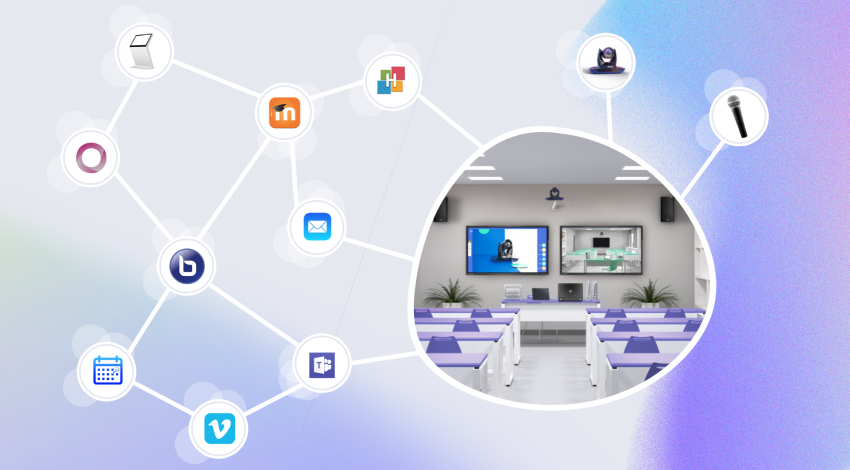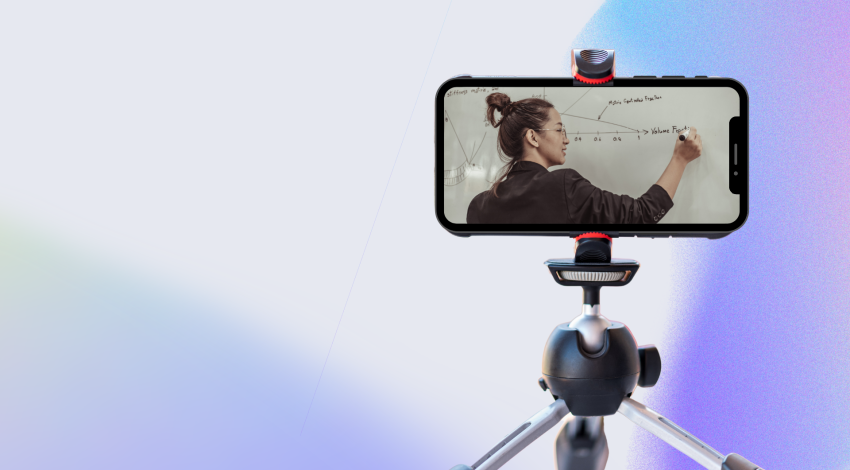

The COVID-19 health crisis has changed the way we teach and learn with online courses. Indeed, we have seen the democratization of co-modal and hybrid forms of teaching in our universities and schools. We talked about this in a previous article. Moreover, with the continuity of the new waves of COVID-19, we see new terms appearing.
HyFlex (a combination of "hybrid" and "flexible") represents hybrid learning. It refers to courses that take place at the same time in the classroom and online. The "flexible" aspect reflects the choice that learners have about how they participate in the course. Either directly face-to-face, online or completely asynchronous with recorded lectures.
In addition, we find the term Phygital which is the contraction between the words "physical" and "digital". It represents the integration of digital activities in face-to-face courses to make them more interactive.
The transmission of knowledge has thus been turned upside down. According to the UN report (2020), COVID-19 has affected more than 1.6 billion learners in over 190 countries. So what can we make of it? How have students and teachers experienced this change and are they still experiencing it? What have been the benefits and new challenges that have emerged with online courses?
The arrival of this pandemic has brought great pedagogical confusion for all teachers. Nevertheless, many have done the impossible by quickly learning about digital solutions to deliver courses at a distance. A few studies on teachers' feelings have emerged since the COVID-19 crisis.
In general, faculty placed a high value on the relationship they could have with their students. This was a key factor in their motivation to use the technologies*. One of the biggest challenges encountered was the transformation of the teaching environment. In particular, the mastery of new technological tools. On the other hand, "the majority of teachers remain quite optimistic about their ability to act". According to the same study, "in the face of this transformation, it is surprising to see that more than 60% of teachers, who are often considered conservative, find this experience rather 'successful'" even though it required a strong investment.
We would like to talk about Nadia NAFFI's experience. In order to illustrate the transition between traditional courses and online courses during the arrival of COVID-19.
The challenges she highlights are the need for efficient internet connections and stable bandwidth. In addition, she highlights the extra workload involved in designing and developing different learning paths. In addition, supporting students and facilitating their learning, regardless of the pathway chosen, is an important aspect to consider.
However, she insists that the implementation of Hyflex courses saved her semester at the beginning of the year 2020. The flexibility offered by this mode of instruction allowed for a quick and seamless transition to a format that worked in the context of the pandemic. It even benefited international students who had to return home but were able to continue learning at a distance.
In closing, she gives her 5 tips for designing a HyFlex course in a COVID-19 pandemic context:
Once that is done, gradually add synchronous and in-class elements to create optional courses. Two things to remember: 1) the pandemic has increased inequality and the digital divide like never before. Not all students will be able to access courses synchronously, and no one should be penalized for not doing so; and 2) the HyFlex course design model is complex, so give yourself permission to experiment the first time you venture into it and learn from any unforeseen miscalculations ;
It can break down. Be sure to alert students and reassure them from day one that if this happens during a synchronous meeting, you will find a plan B to ensure that their learning experience will not be affected by technical problems or lack of access ;
Discuss the difference between a conversation and a monologue in a forum, be explicit about quality versus quantity in asynchronous discussions, and explain the difference between engagement and last-minute posts;
Through different modes requires effective and efficient collaboration, both between students and faculty, and among students themselves. Empower your students to become proactive, to have a voice, to take control of their learning experience, and make them aware of the importance of supporting those who struggle.
As well as the solutions they might propose. Their formative feedback could give you good insight into what works and what to avoid, especially in times of uncertainty."
Numerous studies could be conducted on the different perceptions of students in relation to their online learning experiences.
Flexibility: in terms of time and space, it is possible to be in your own environment and study at your own pace.
Accessibility: learners agree that e-learning helps them by providing asynchronous access to learning materials at any time of the day.
Cost: Online learning reduces the cost of education. Students stay at home and do not pay travel or other expenses. However, this must be contrasted with the cost of electricity, water, and internet charges, which can increase by staying at home.
Acquisition of new skills: Online courses can stimulate new skills such as time management and self-discipline.
Offer new opportunities: The dematerialization of courses increases the possibilities of meeting and collaborating. Especially with professionals who are experts on a global scale and in all fields of education. According to one study**, more than 50% of participants said that online courses are beneficial to them because they provide them with substantial authentic resources of material needed for their professional and academic activities.
However, challenges and issues also emerged. Indeed, one of the most dominant constraints is the lack of interaction and direct communication between students and between students and teachers. This aspect can cause great demotivation and therefore difficulties in following the online courses. Moreover, this phenomenon is accentuated by the voluntary non-use of webcams by students.
Then, technical problems related to computer equipment (internet connection, computer speed...) are one of the biggest problems encountered. Consequently, a lack of motivation to attend classes occurs and with it a difficult time management. Moreover, concerns about privacy (data collected, videos from students' webcams...) emerge with this new way of studying.
According to the students' profile, the autonomy and freedom offered by online courses represent a great challenge to stay focused on their learning.
All of these elements that change the habits of traditional training can contribute to the social isolation of students or to problems of success during exams.
Generally speaking, according to students, online learning is a relaxed and productive source of knowledge. It meets the needs of a growing population of students. Especially for those who cannot or do not prefer to participate in traditional courses.
Online courses can be a long-term strategy for higher education if the appropriate technology is used.
Furthermore, if the technological variable is mastered (digital hardware and software) it will allow faculty, students, and university administrators to collect data, feedback, and evaluations regarding their online experiences. Finally, it would make the delivery of knowledge accessible to learners who are deaf, hard of hearing, or have special needs, which was not readily available when COVID-19 began.
* Higher education teachers facing "forced" online teaching - What changes in their relationship to digital education? by Jacques Audran, Tomas Kaqinari, Dominique Kern and Elena Makarova (2021).
** Paudel, P. (2021). Online education: Benefits, challenges and strategies during and after COVID-19 in higher education. International Journal on Studies in Education (IJonSE), 3(2),70-85
_
Higher Education Teachers Facing "Compelled" Online Education - What Changes in their Relationship to Digital Education? by Jacques Audran, Tomas Kaqinari, Dominique Kern and Elena Makarova (2021)
Online education: Benefits, challenges, and strategies during and after COVID-19 in higher education - Paudel, P. (2021).
Teachers' and students' perceptions of online learning during COVID-19 - Zakaryia Almahasees, Khaled Mohsen and Mohammad Omar Amin (2021).
Evaluation of Online Learning in Higher Education: Study Survey Method - Hengki Wijaya, Leonard Sumule, Ivan Th. J. Weismann, Tri Supartini, Ezra Tari (2021)
Online learning during the Covid-19 pandemic: A student satisfaction survey - Nor Azwahanum Nor Shaid, Fathiyah Mohd Kamruzaman & Nur Ainil Sulaiman (2021)
Students' perception of online learning during the COVID-19 pandemic A survey study of Polish medical students - Michał Bączek, Michalina Zagańczyk-Bączek, Monika Szpringer, Andrzej Jaroszyński, & Beata Wożakowska-Kapłon (2021).
Online teaching and learning experiences during the COVID-19 pandemic - Comparing teacher and student perceptions - Sut Ieng Lei and Amy Siu Ian So (2021).
The Hyber-Flexible (HyFlex) course design model: A pedagogical strategy for uncertain times - Nadia Naffi (2020)

